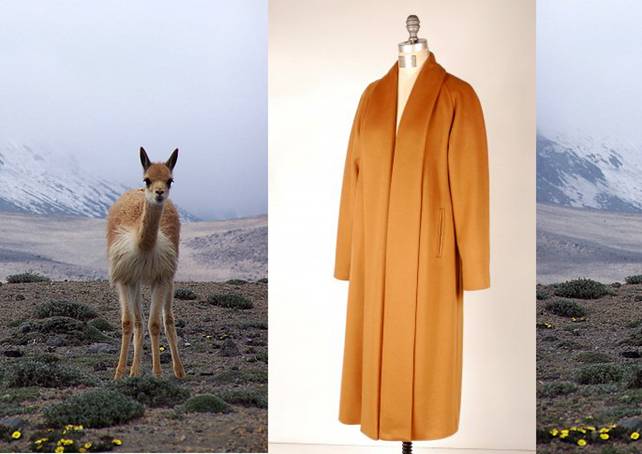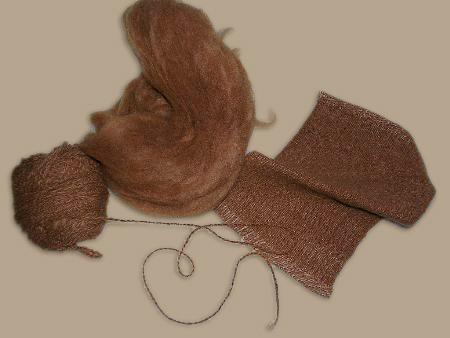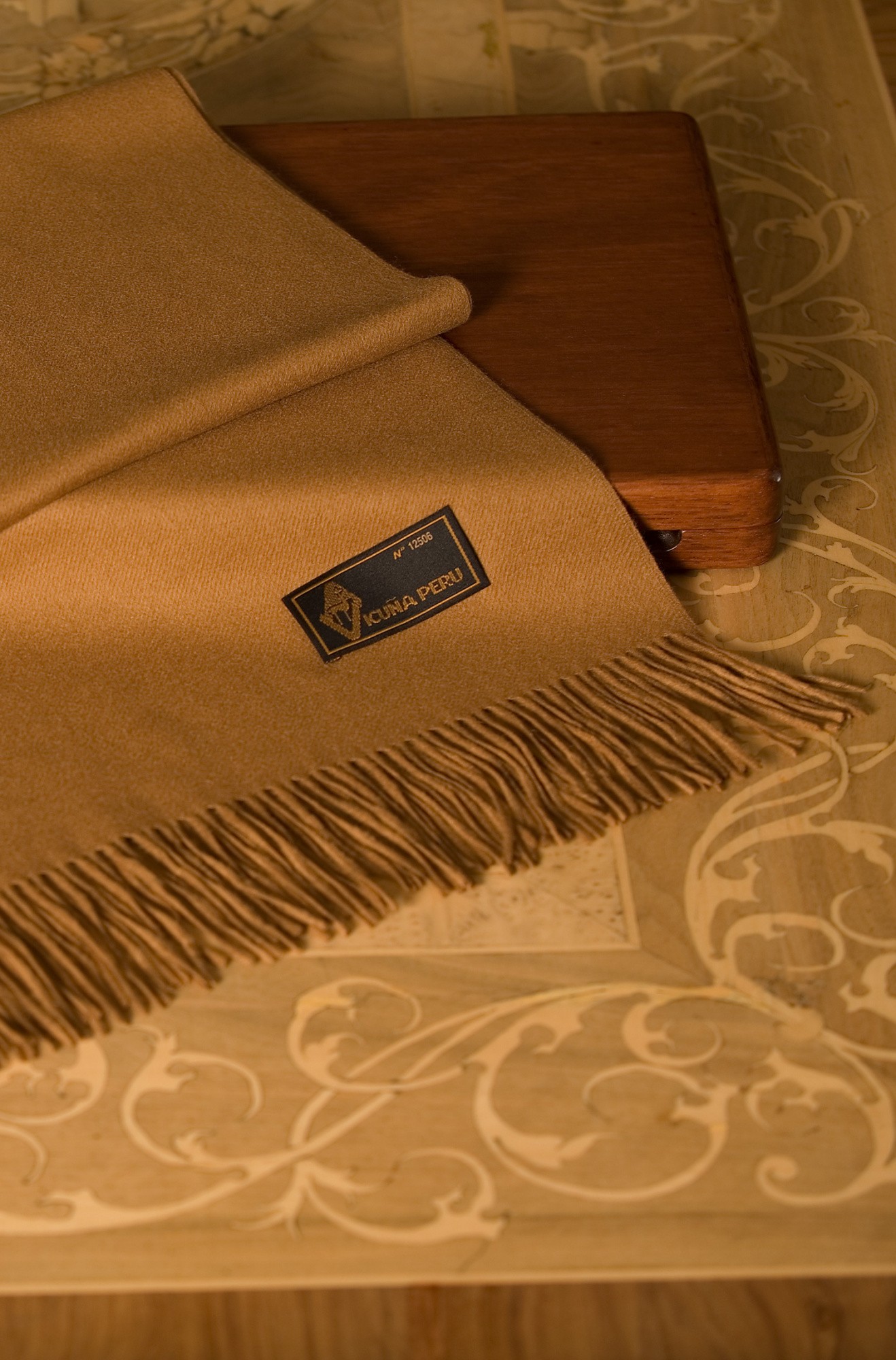VICUÑA
Статья про викунью
Vicuna lives in the harsh conditions of the highlands, where it is always cold, strong wind blows, and there is little oxygen, water, and food. But it is perfectly adapted to them. Not only that, the Creator rewarded her with grace and beauty, and an amazing coat that protects from cold and bad weather, allows you to survive in the mountains. Wool is very thin, soft and durable. It makes wonderful fabrics. Wool and killed the animals. Because of it, people killed almost all the vicunias by the early 60s of the XX century.

Vicuna, caught in the Chuck


Now, thanks to special protection measures, the vicuna are saved. They are protected not only by international agreements and laws, but also by the peasants on whose lands they live. Now the Andean highlanders – the quechuans and Aymaras - again take care of the vicuna and get their wool from them, without killing them, as in the days of their forefathers under the Incas. To do this, they use the method of collective bloodless hunting, which was used by the Incas in order to catch and cut off live vicunias (see § 2 "Inca Empire" of the study "Chronicle of the exploitation of vicunias"). It's called Chaku. And this precious wool gives the Indians the means to get out of total poverty. The use of wikunias is controlled by the state.

An important role in protecting the vicuna is played by a special system of trade in its wool, defined by international treaties. It, in particular, involves the issuance of special permits to sellers and buyers of wool and manufacturers of goods made from it. Without them, the trade is illegal, as there is a possibility that the wool was obtained from animals killed by poachers. In order to distinguish products made from wool cut from live vicunias, the Convention on international trade in endangered species of Wild animals and plants (the Convention on International Trade in Endangered Species of Wild Fauna and Flora – CITES) has approved special brands "VICUÑA-STRAON the ORIGIN" (for example, "VICUÑA-PERÚ" - in the photo;) and "VICUÑA COUNTRY of ORIGIN-ARTESANÍA" [1] (for example, "VICUÑAPERÚ-ARTESANÍA"). The brand "VICUÑA - country of ORIGIN" is intended for industrial textile and knitwear companies and is applied to fabrics, as well as sewn to knitwear. Brand " VICUÑA STRAON the ORIGIN-ARTESANÍA " is intended for craft enterprises.
Vicuna wool is very light and strong. It has unique thermal insulation properties. It is not accepted to paint it, since any chemical influence violates the delicate structure of the fiber. Vicuna wool is the rarest, thinnest and most expensive in the world. Like the vicuna itself, it is covered with legends. It is called "wool of the gods". It is the national pride of Peru. For example, on November 30, 2009, the then President of Peru, Alan Garcia, presented Pope Benedict XVI with a vicuna wool Cape at a private audience.

At the twentieth annual meeting of leaders of the Asia-Pacific economic cooperation (APEC), held on November 22 – 23, 2008 in the capital of Peru, Lima, each of them was presented with a poncho made of vicuna wool.

The legendary fame of the vicuna undoubtedly adds to the price of its wool. On the world market in 2003, about 850 us dollars were paid for a kilogram of vicuna wool, while only 14-15 us dollars were paid for a kilogram of Alpaca wool (see the table). In 2007, the price of a kilogram of vicuna wool reached $ 940, and in 2010 - $ 2000..

Tonina and the price of wool of various animals (2003)
|
Wool |
Tonina (microns) |
Price per 1 kg (us dollars) |
| Vicuna |
10 – 15 |
850 |
| Alpaca & nbsp; baby |
22,5 |
14,0 |
| Alpaca & nbsp; Suri |
26,0 |
9,0 |
| Alpaca & nbsp; superfina |
26,5 |
9,0 |
| Yak |
19 – 21 |
19,0 |
| Cashmere |
15 – 19 |
80,0 |
| Kid-mohair |
25,0 |
27,0 |
| Young mohair |
28,0 |
21,0 |
| Adulto-mohair |
35,0 |
11,5 |
The cost of a meter of fabric (contains about 300 g of wool) a couple of years ago, according to the website Peruecologico and Spanish-language Wikipedia, was 1000 – 3000 dollars. In November 2008, the company "Loro Piana" reported that the fabric from vicuna wool is sold at a price of about 1000-2000 pounds per meter. Today (December 2010) Wikipedia gives only the price of 3000 dollars. per meter. This is probably the lower mark. Buyers of such fabrics, as a rule, are high fashion houses in France and Italy, which sew exclusive clothes from them.


The photo shows clothing made of vicuna wool from the Italian company "Loro Piana" – one of the world leaders in the production of fabrics and luxury clothing collections. This company was founded in 1812 and now it has more than 100 boutiques around the world. In the photo on the left – a knitted Polo shirt, a man's scarf and a coat with a removable mink lining. In the photo in the center-a stole and a knitted cardigan. The photo on the right shows a coat made of vicuna wool mixed with baby cashmere, a chinchilla collar and cuffs.

14 g of wool
The average cost of a vicuna wool coat in Europe or Japan was between $ 6,000 and $ 22,000.. But while I was collecting material for my research, the average price of a coat (2010) in the luxury market increased to about $ 18,000. (in the US) and $ 20,000. (in China) – products of the company "Hermenegildo Zegna" (Italy), and the maximum – up to 30,000 dollars. (the company "Loro Piana"). A jacket or jacket can cost up to 15,000 USD. («Hermenegildo Zegna»).
To reduce the cost of yarn, manufacturers often mix vicuna wool with the wool of other animals, as well as with silk.
However, the price that exporters pay to producers for wool is much lower. So, in Peru at the end of November 2009, a kilogram of dirty wool cost about 345 dollars, pre-cleaned-500 dollars, and cleaned-600 dollars. In the fall of 2010, prices generally rose. A kilogram of dirty wool cost about 385 dollars, but pre-cleaned-only 450 dollars, but cleaned-650 dollars.
A kilogram of wool is obtained from cutting five animals. With one vicuna cut an average of 200-250 g for a new haircut, the wool needs to grow. According to scientists, it is possible to cut vicunias only when the length of the coat is at least 3 cm, so that at least 0.5 cm is left on the animal. For processing, the length of shorn wool, in accordance with the requirements of the world market, should be at least 2-2.5 cm. It grows quite slowly. Therefore, they cut vicunias every 2 years.
The hair tone can range from 10 to 16 microns. But these are marginal figures. Usually the Tonina of vicunia wool is 12-13 microns, or better to say less than 13 microns, and the length is more than 3 cm. But the wool cover of the vicuna, as in other representatives of the family camelidae, consists of the covering hair, which makes up the awn, and the undercoat (undercoat). In other words, in addition to the fine and soft wool used to produce yarn, the vicuna rune has a tinted awn of about 25 microns – coarser long silky hairs with a characteristic sheen. The remaining hair is usually removed manually. This is a long and time-consuming process. As a result of complete manual cleaning of 250 g of wool, only 120 g remains. (If you clean the wool on the machine, it remains half as much.) According to the company "Loro Piana", to make a scarf, you need more than 1 cleaned fleece, a pullover – 5, a coat – from 25 to 30.

For example, I give the weight, size and price (2009) of products from one of the British online stores that specialize in products made from South American camel wool.

Poncho made of 100% vicuna wool. Size 150 × 160 cm. Weight 550 g. Price 2300 pounds.


100% vicuna wool stole. Size 200 × 70 cm. Weight 200 g. Two color options. Price 974.83 pounds.

As for the manual knitwear made of vicuna wool, there is almost no information about it. I only found a photo of a Peruvian knitted shawl. And I know more about handmade fabrics, but not about Peruvian ones, but about Argentinean ones.

In Argentina, in the province of Catamarca, the tradition of making fabrics from vicuna wool was not interrupted. Therefore, it has its roots in ancient times.
The Andean Indians preserved the ancient weaving technique of the Incas, which they in turn borrowed from the peoples they conquered. Using only a wooden spindle for spinning and the most primitive hand loom, the ancestors of modern quechuans and aymars made wonderful fabrics from camel wool. Vicuna wool was used for the manufacture of very high quality fabrics already by the Paracas culture in the first Millennium BC, as well as subsequent cultures that existed on the Peruvian coast, especially the kingdoms of Nazca and Wari Tiahuanaco, and, of course, the Inca Empire. After the Spanish conquest, the Indians mastered the Spanish pedal press, which allowed them to produce fabrics wider and longer than the Inca machine.
Ancient methods of weaving from vicuna wool are used today by some communities of Catamarca province, as well as residents of the small town of belén, which made its province famous with homespun products not only from vicuna wool, but also from llama and sheep wool. The weaving technique is passed down through the generations by the women of the city.
The Association of spinners and weavers of vicuna "homeland of poncho" Belen specializes in fabrics made of vicuna wool. The website where the Association sells its products emphasizes that the wool from which their fabrics are made is only legal. It is cut from live animals and has all the necessary documents.
According to the latest (2008) national census of vicunas, in the province of Catamarca lives 40 500 vicunas. Only in this province of Argentina to a limited extent control the population of vicunas in the wild. Vicuna management has been carried out here on a permanent basis since 2003 after the approval of Cites in 2003 of the transition of the entire population of vicuna of Catamarca province to Annex II. At that time, Argentina was granted permission for international trade in wool cut from live vicunias, fabrics, ready-made industrial and Handicrafts under the brand name "VICUÑA-ARGENTINA".
Catch and shear vicunas that live in the nature Reserve of Laguna Blanca (Laguna Blanca) and its surroundings. This is done by members of the Laguna Blanca community.
The resulting wool is mainly used for making craft textiles. Part of the wool that goes to the state for the use of vicunias (a state resource) is distributed among the artisans of Catamarca province. The Laguna Blanca cooperative distributes a portion of its wool (80%) to members of its community who weave and then sell their products. In addition, the cooperative sells some of its wool to other artisans, mostly from henbane.
Weavers are very happy that they can now work freely with vicuna wool. This was previously forbidden because wool was illegal. To avoid prison, it was believed that one had to weave only in the moonlight.
However, weaving does not provide a stable income yet. To survive, weavers have to engage in cattle breeding, and grow vegetables and grains to feed their families. This is because the market for homespun products made from vicuna wool is very unstable and largely depends on tourists. But fortunately, now it began to expand, as already private companies began to show interest in these products.
The Belen Association of vicuna spinners and weavers "homeland of the poncho" produces very light fabrics from very fine hand-spun vicuna wool.

The Rodina poncho Association mainly produces capes (mantas) , as well as ponchos, scarves, ties (corbatines), etc. Yarn from vicuna wool is usually not colored and all products from it are woven in plain colors. Capes are sometimes decorated with embroidery, also plain. Ponchos made from vicuna wool, unlike ponchos made from the wool of other animals, are also not made multicolored to emphasize their origin from the vicuna, so valued at all times. They always have a natural vicuna color.
The weight of products is measured only in grams, although their dimensions are not small. For example, a vicuna wool Cape is 2.30 m long and 1.30 m wide. In order to weave such a Cape, you need to work 15 days for 8 hours.



Cape (manta), tie (corbatines) and poncho made of vicuna wool of the Association "homeland of ponchos"
Each product is unique. It takes a lot of patience and diligence to make it. Belen weavers are proud that they have managed to keep their ancient art alive to the present day.



Poncho of vicuna wool, the size of 1.82×1.84 m, XIX century
The fineness and softness of the products of Belen weavers, and in particular ponchos, is striking. Argentine ponchos made from vicuna wool are considered the lightest in the world. However, originally the ancient shepherds made their ponchos from thick yarn to save them from the cold. And with the help of a special technique, the weavers achieved that the front side of the poncho was dense. As a result, the vicuna wool poncho became almost waterproof.
But after the Spanish conquest, the Indians, according to Mayne Reid, were forced to give all the skins of vicunias that they obtained on a collective hunt to a priest assigned to their community, who had to pay a tax on these skins to the state. The Indians got only the meat of animals. So they could no longer have a vicuna wool poncho. Wool cost a lot of money and was exported to Europe.
"When Pizarro and his Spaniards first penetrated the mountainous regions of Peru, they were surprised to see new animals for them: the llama, the guanaco and the vigon (vicuna-F. O.). the guanaco wool is of poor quality, and its meat is considered tasteless, but the fine wool of the vigoni is made into cloaks, which are then sold for twenty or even thirty pounds apiece. In those parts everyone considers it their duty to get a similar cloak or poncho; it is clear that only the rich can wear cloaks made of pure wigoni wool, and Indians, shepherds, and Colliers are content with ponchos made of llama wool, " wrote Mayne Reid in the mid-nineteenth century.
In his work "Exiles in the forest", Mayne Reid describes the clothing of a rich Creole, a native of Cuzco (Peru), don Pablo, together with his family fleeing in the mountains from the persecution of the authorities (what happens in the novel belongs to the very beginning of the XIX century):
"He was dressed in velvet trousers trimmed with leather at the bottom, boots of yellow leather, and a dark, tightly buttoned jacket, girdled with a red silk belt, the long ends of which, fringed, hung on the left side. Strapped to his belt was a Spanish knife and two silver-rimmed pistols, elaborately trimmed. But all this was hidden under a voluminous poncho, a garment that in South America serves as a cloak by day and a blanket by night. It is just a piece of cloth, the size and shape of an ordinary blanket, with a hole in the middle for the head. In Mexico, almost everyone wears such clothing, called there "serape". Don Pablo's poncho was made of fine vigoni wool and cost at least twenty pounds, and it protected him not only from the cold, but, like his Mackintosh, from the rain. <... & gt; don Pablo's Clothes were expensive, which showed that he was a rich and noble man."
It is interesting that don Pablo's wife, a "dark and beautiful Spaniard", wore a vicuna cloak (poncho) over a "black silk dress with a velvet, beautifully embroidered bodice", while the Indian women did not wear ponchos.
Ponchos became the favorite clothing of Spanish riders soon after their arrival in South America. It was for them that they began to produce light and thin ponchos made of vicuna wool.

The Mariner
Thin ponchos made of vicuna wool were part of the riding costume of Chalan (chalán) – a rider and landowner of the Northern coast of Peru (Piura, Trujillo, Chiclayo). In our time, a Chalan is a person who is engaged in breeding and training a special Peruvian breed of horse-caballo peruano de paso[1], bred during the colonial period in Peru and is part of the culture of the country. These horses, in particular, are known for being trained to perform a special trot. Interestingly, there is a variant of the national Peruvian dance Mariner (marinera), in which a girl dances with a Chalan on such a horse. The dress suits of modern chalans have not undergone any special changes.


It is difficult, of course, to judge the beauty of Handicrafts made of vicuna wool from photographs. The only thing that definitely won me over is the Cape (manta) handmade from Bolivia. The price of 1450 dollars. Size 120 × 175 cm. Weight about 796 g.
It remains to say that most of the vicuna wool exports, and therefore produces Peru (50 %), followed by Bolivia, Argentina and Chile.
Vicuna wool exports in 2008 by country

Source : vicuna.ru
- Comments
